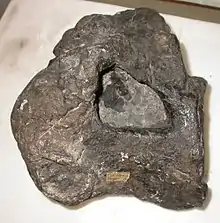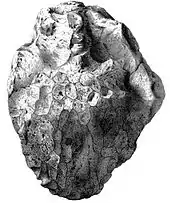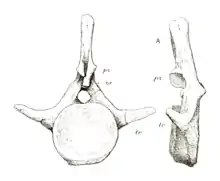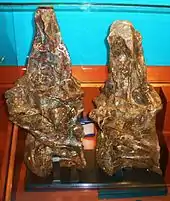Ornithopsis
Ornithopsis (meaning "bird-likeness") was a medium-sized Early Cretaceous sauropod dinosaur, from England.[1] The type species, which is the only species seen as valid today, is O. hulkei.[2]
| Ornithopsis | |
|---|---|
 | |
| Lectotype vertebra NHMUK R28632 | |
| Scientific classification | |
| Kingdom: | Animalia |
| Phylum: | Chordata |
| Clade: | Dinosauria |
| Clade: | Saurischia |
| Suborder: | †Sauropodomorpha |
| Clade: | †Sauropoda |
| Clade: | †Eusauropoda |
| Clade: | †Neosauropoda |
| Clade: | †Macronaria |
| Clade: | †Titanosauriformes |
| Genus: | †Ornithopsis Seeley, 1870 |
| Species: | †O. hulkei |
| Binomial name | |
| †Ornithopsis hulkei Seeley, 1870 | |
| Synonyms | |
| |
History of discovery

The type species, Ornithopsis hulkei, was named and described by Harry Govier Seeley in 1870. The type consisted of two dorsal vertebrae: NHMUK R.2239, found in the Hastings Group of East Sussex, and NHMUK R.28632 found on the Isle of Wight in the Wessex Formation dating from the Barremian. The genus name is derived from Greek ornis (ὄρνις, "bird") and opsis (ὄψις, "face" or "likeness"), a reference to the fact that Seeley considered the animal to be an intermediate form bridging the gap between pterosaurs, birds and dinosaurs. The specific name honours John Whitaker Hulke.[2]
Seeley's creation of the genus was, however, not accepted by Richard Owen, who rejected the evolutionary interpretation of the material. Disregarding priority, he therefore in 1875 split it, making NHMUK R2239, that he had in 1841 described as the quadrate of Iguanodon, the holotype of Bothriospondylus elongatus, and making NHMUK R.28632 the holotype of Bothriospondylus magnus.
As a result of the split both vertebrae now went their separate nomenclatural way. BMNH R28632 was in 1876 by Owen made the type of Chondrosteosaurus magnus.[3] John Whitaker Hulke made NHMUK R.28632 the lectotype of O. hulkei, rendering Bothriospondylus magnus a junior objective synonym.[4] By 1882, Hulke grouped all vertebrae of Ornithopsis and Eucamerotus under the new name Ornithopsis eucamerotus along with a set of three pelvic bones (NHMUK R.97, R.97a), and recognized the Bothriospondylus elongatus holotype as being distinct from NHMUK R.28632 in proportion.[5] In 1995 William Blows restricted Ornithopsis to NHMUK R.28632, assigning other vertebrae referred to the genus to Eucamerotus and agreeing with Hulke (1879) the Bothriospondylus elongatus holotype was older than the Ornithopsis lectotype and not conspecific.[6]

In 1887 Hulke named Ornithopsis leedsii for NHMUK R1984-1988, vertebrae and partial remains of a pelvis found by Alfred Nicholson Leeds near Peterborough.[7] Specimen NHMUK R1984, some vertebrae, was thought to belong to the syntype series but is actually a different individual.[8] This species would be renamed Cetiosaurus leedsi and later Cetiosauriscus leedsii, both today seen as incorrect identifications.
The Ornithopsis hulkei holotype is basically a centrum lacking the neural spine. The vertebra is heavily pneumatised, filled with large cavities, camellae. It is narrow, tall, has a ridge on the underside, is opisthocoelous and has a posteriorly placed deep subtriangular pleurocoel over two thirds of its length. These features are compatible with a placement within the Titanosauriformes.[9]
Species

- O. hulkei Seeley 1870 (type)
- O. eucamerotus Hulke 1882 - nomen dubium (See Eucamerotus)
- O. leedsii Hulke 1887 = Cetiosaurus leedsi (Hulke 1887) Woodward 1905 = Cetiosauriscus leedsii (Hulke 1887) von Huene 1927 = nomen dubium; indeterminate beyond Eusauropoda.[10]
Misassigned species
- O. greppini von Huene 1922 = Amanzia
References
- Upchurch, P. & Martin, J. 2003. The anatomy and taxonomy of Cetiosaurus (Saurischia, Sauropoda) from the Middle Jurassic of England. Journal of Vertebrate Paleontology, 23, 208–231.
- Seeley, H.G., 1870, "Ornithopsis, a gigantic animal of the Pterodacyle kind from the Wealden", Annals and Magazine of Natural History, 4th series 4(5): 305-318
- Owen, R. 1876. "Monograph on the fossil Reptilia of the Wealden and Purbeck Formations. Supplement 7. Crocodilia (Poikilopleuron) and Dinosauria? (Chondrosteosaurus)", Palaeontographical Society Monographs 30 : 1-7
- Hulke, J. W. (1879). "Note (3rd) on (Eucamerotus, Hulke) Ornithopsis, H. G. Seeley, = Bothrospondylus magnus, Owen, = Chondrosteous magnus, Owen". Quarterly Journal of the Geological Society. 35: 752–762. doi:10.1144/GSL.JGS.1879.035.01-04.55.
- Hulke, J. W. (1882). "Note on the Os Pubis and Ischium of Ornithopsis eucamerotus". Quarterly Journal of the Geological Society. 38 (1–4): 372–376. doi:10.1144/GSL.JGS.1882.038.01-04.41.
- Blows, W.T. (1995). "The Early Cretaceous brachiosaurid dinosaurs Ornithopsis and Eucamerotus from the Isle of Wight, England" (PDF). Palaeontology. 38 (1): 187–197.
- Hulke, J.W. (1887). "Note on some Dinosaurian Remains in the Collection of A. Leeds, Esq. Part I. Ornithopsis leedsii, nov. sp, from the Kimmeridge Clay of Northamptonshire". Geological Magazine. 4 (8): 375–376. doi:10.1017/S0016756800194014.
- Noè, L.F., Liston, J.J., and Sandra D. Chapman, 2010, "'Old bones, dry subject': the dinosaurs and pterosaur collected by Alfred Nicholson Leeds of Peterborough, England". In: Moody, R.T.J., Buffetaut, E., Naish, D.W. and Martill, D.M. (eds.) Dinosaurs and Other Extinct Saurians: a Historical Perspective. Series: Geological Society Special Publication (343). The Geological Society, pp. 49-77
-
- Upchurch, P., Mannion, P. D. & Barrett, P. M. 2011. Sauropod dinosaurs. In Batten, D. J. (ed.) English Wealden Fossils. The Palaeontological Association (London), pp. 476-525.
- Mannion, Philip D.; Upchurch, Paul; Barnes, Rosie N.; Mateus, Octávio (2013). "Osteology of the Late Jurassic Portuguese sauropod dinosaur Lusotitan atalaiensis (Macronaria) and the evolutionary history of basal titanosauriforms". Zoological Journal of the Linnean Society. 168: 98–206. doi:10.1111/zoj.12029.












